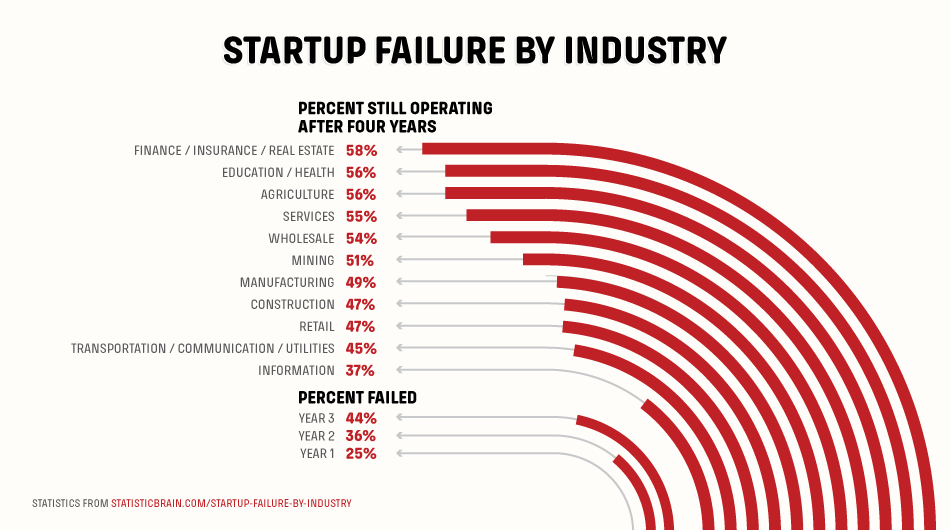The High Failure Rate Of Food Startups: What Founders Can Do Differently

Table of Contents
Common Reasons for Food Startup Failure
The high failure rate of food startups isn't due to a single factor but rather a confluence of challenges. Understanding these pitfalls is the first step towards avoiding them.
Lack of Market Research and Validation
Many food startups fail because they lack a deep understanding of their target market. Insufficient market research leads to flawed assumptions about consumer preferences, demand, and competition.
- Insufficient understanding of target audience needs and preferences: Failing to identify the specific needs and desires of your target demographic can result in a product that simply doesn't resonate with consumers. Are you targeting health-conscious millennials, busy families, or gourmet food enthusiasts? Understanding this is paramount.
- Failure to validate product-market fit before significant investment: Launching a product without first testing its appeal in the market is a recipe for disaster. A minimum viable product (MVP) allows you to gather crucial feedback and make necessary adjustments before investing heavily in production and marketing.
- Overlooking competitor analysis: A thorough competitive analysis is essential to identify your unique selling proposition (USP) and differentiate your brand in a crowded market. What are your competitors doing well? Where are their weaknesses? How can you offer something better or different?
- Examples of poorly researched food startups: Many gourmet popcorn brands have failed due to a lack of understanding of the existing market saturation and price sensitivity of consumers. Similarly, some niche health food brands struggled due to limited appeal beyond a very specific demographic.
Poor Financial Management
Even the most innovative food product will fail without sound financial management. Underestimating costs and mismanaging cash flow are frequent culprits in food startup failure.
- Underestimating startup costs and ongoing operational expenses: Food businesses often require significant upfront investments in equipment, ingredients, permits, and marketing. Failing to accurately account for these costs can lead to financial strain.
- Ineffective cash flow management leading to insolvency: Maintaining positive cash flow is critical for survival. Understanding your burn rate and having sufficient working capital are essential to navigate lean periods.
- Lack of a robust financial plan and forecasting: A well-defined financial plan, including detailed projections and key performance indicators (KPIs), provides a roadmap for success and helps you track progress and make informed decisions.
- Essential financial planning tools for food businesses: Utilizing tools like QuickBooks, Xero, or FreshBooks can help streamline accounting and provide valuable insights into your financial health.
Inadequate Operations and Logistics
Efficient operations and a reliable supply chain are paramount in the food industry. Issues in these areas can severely impact your ability to deliver your product consistently and profitably.
- Supply chain issues and unreliable sourcing of ingredients: Consistent access to high-quality ingredients is crucial. Establishing strong relationships with reliable suppliers is essential to avoid disruptions and maintain product quality.
- Problems with food safety and regulatory compliance: Food safety is non-negotiable. Strict adherence to all relevant regulations and maintaining impeccable hygiene standards are paramount to avoid costly recalls and legal issues.
- Inefficient production processes and high waste: Optimizing production processes to minimize waste and maximize efficiency is critical for profitability. Implementing lean manufacturing principles can significantly improve operational efficiency.
- Best practices in food production and logistics: Investing in efficient equipment, implementing robust inventory management systems, and establishing clear production protocols are crucial elements of successful operations.
Ineffective Marketing and Branding
A great product won't sell itself. Effective marketing and branding are vital to create awareness, attract customers, and build a loyal following.
- Failure to create a strong brand identity and messaging: Your brand identity should clearly communicate your values, mission, and unique selling proposition. A consistent brand message across all platforms is crucial.
- Lack of targeted marketing strategies to reach the intended audience: Understanding your target market is critical for selecting the right marketing channels and tailoring your messaging effectively.
- Insufficient use of social media and online platforms: Leveraging social media and online marketing channels is essential for reaching a wider audience and building brand awareness.
- Successful food startup marketing examples: Companies like Chobani and Impossible Foods have demonstrated the power of targeted marketing and strong brand storytelling.
Strategies for Mitigating Food Startup Failure
By proactively addressing the challenges discussed above, food entrepreneurs can significantly improve their chances of success.
Conduct Thorough Market Research
Before investing significant resources, conduct comprehensive market research to validate your product idea and understand your target market.
- Detailed consumer surveys and focus groups: Gather valuable insights into consumer preferences, needs, and willingness to pay.
- Competitive analysis to identify market gaps and opportunities: Identify your competitors' strengths and weaknesses to find your niche and develop a compelling unique selling proposition (USP).
- Testing minimum viable products (MVPs) to validate market demand: Launch a small-scale test to gather real-world feedback before committing to large-scale production.
- How to effectively conduct market research: Utilize online surveys, conduct in-person interviews, analyze competitor data, and leverage market research reports.
Develop a Solid Business Plan
A well-structured business plan serves as your roadmap for success. It should outline your business model, financial projections, marketing strategy, and operational plan.
- Detailed financial projections and realistic revenue forecasts: Accurate financial modeling is crucial for securing funding and managing your finances effectively.
- Clearly defined target market and marketing strategy: Identify your ideal customer and develop a targeted marketing plan to reach them effectively.
- Comprehensive operational plan, including sourcing, production, and distribution: Outline all aspects of your operational processes, including sourcing ingredients, production methods, and distribution channels.
- Key components of a successful food startup business plan: Include an executive summary, company description, market analysis, marketing plan, financial projections, and management team overview.
Secure Adequate Funding
Securing sufficient funding is critical for covering startup costs and navigating the initial growth phase.
- Exploring various funding options, such as bootstrapping, angel investors, venture capital, and loans: Each option has its own advantages and disadvantages; choose the most suitable one for your needs and situation.
- Creating a compelling pitch deck to attract investors: Develop a concise and persuasive pitch deck that clearly articulates your business model, market opportunity, and financial projections.
- Understanding the terms and conditions of funding agreements: Thoroughly review all funding agreements to understand your obligations and protect your interests.
- Comparing different funding options for food startups: Consider the equity dilution, interest rates, and repayment terms associated with each option.
Build a Strong Team
Surrounding yourself with a skilled and dedicated team is crucial for success.
- Hiring experienced professionals in relevant fields, such as food science, marketing, and finance: Assemble a team with the necessary expertise to manage all aspects of your business.
- Creating a positive and collaborative work environment: Foster a culture of teamwork, innovation, and open communication.
- Effective delegation and management of tasks: Delegate tasks effectively and provide clear guidance and support to your team members.
- Importance of team building and leadership in food startups: Strong leadership and effective team dynamics are crucial for navigating challenges and achieving common goals.
Conclusion
The high failure rate of food startups underscores the challenges involved in this competitive industry. However, by understanding the common reasons for failure and implementing the strategies outlined in this article, you can significantly improve your chances of success. By carefully planning, researching, and executing your food startup strategy, you can significantly increase your chances of success and avoid becoming another statistic in the high failure rate of food startups. Learn more about [link to relevant resources, e.g., SBA resources, industry publications] to build your successful food business.

Featured Posts
-
 New York Rangers Roster Changes And Their Implications
May 29, 2025
New York Rangers Roster Changes And Their Implications
May 29, 2025 -
 Mickey Rourkes Celebrity Big Brother Comment Aj Odudus Official Response
May 29, 2025
Mickey Rourkes Celebrity Big Brother Comment Aj Odudus Official Response
May 29, 2025 -
 Live Nation Faces Doj Lawsuit Over Alleged Venue Coercion
May 29, 2025
Live Nation Faces Doj Lawsuit Over Alleged Venue Coercion
May 29, 2025 -
 How To Train Your Dragon Toothless Vs Red Death Size Comparison
May 29, 2025
How To Train Your Dragon Toothless Vs Red Death Size Comparison
May 29, 2025 -
 Eurovision 2025 Understanding The Netherlands C Est La Vie Lyrics Artist And Predictions
May 29, 2025
Eurovision 2025 Understanding The Netherlands C Est La Vie Lyrics Artist And Predictions
May 29, 2025
